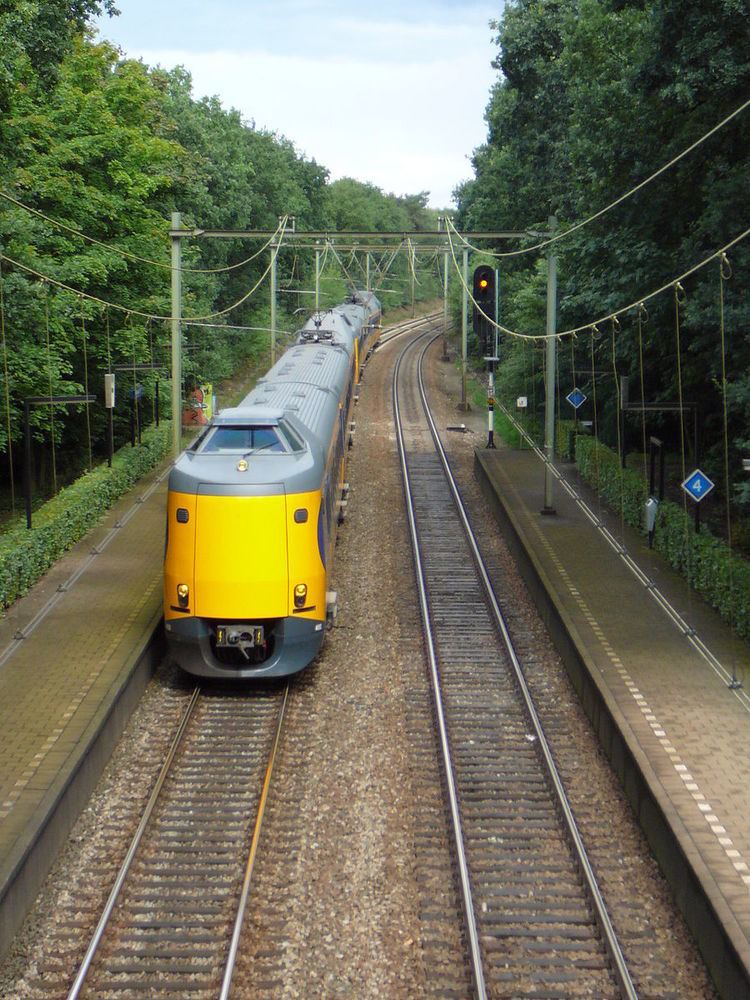Status Operational | Opened 1874–1876 Line length 106 km (66 mi) | |
 | ||
Track gauge 1,435 mm (4 ft 8 ⁄2 in) standard gauge Terminis | ||
The Amsterdam–Zutphen railway is a railway line in the Netherlands – running from Amsterdam to Zutphen; the line passes through the towns Hilversum, Amersfoort and Apeldoorn. It is also informally called the Oosterspoorweg ("eastern railway"), with the part between Amsterdam and Amersfoort sometimes being called the Gooilijn ("Gooi line").
Contents
History
The railway between Amsterdam and Amersfoort was opened by the Hollandsche IJzeren Spoorweg-Maatschappij in 1874 with the Amersfoort–Zutphen section opening in 1876. It was intended as an alternative connection between Amsterdam and the German border and competed with the Staatsspoor-run Amsterdam–Arnhem railway (Rhijnspoor).
Trajectory
The railway begins at Amsterdam Centraal. Between Centraal and just before Amsterdam Muiderpoort railway station, the railway is six tracks-wide; at Amsterdam Muiderpoort, two tracks diverge off towards Utrecht Centraal (cf. Amsterdam–Arnhem railway). Through the eastern side of Amsterdam Muiderpoort, there are eight tracks towards Weesp – just two of these tracks are for trains calling at the station. South of this station, the railways goes back to six tracks as it crosses the Ringvaart. 500 metres east of Amsterdam Muiderpoort is the entrance to Watergraafsmeer rail depot; this is also the point where the Schiphol freight bridge is located. At this point, the line goes to two tracks. The view of the depot is not perfect from the railway. At the end of the depot the railway goes over the A10 ring road of Amsterdam. At Diemen station there is a short section of 3-track railway, this stays as 3 tracks until just before Gaasperdammerweg Junction, before this point there is a single track line coming from Watergraafsmeer depot.
The railway line crosses the river Diem, then it becomes a 4-track railway, with two tracks joining from Schiphol. Once the lines have all joined, the line continues as a 6-track section, crossing the A9. It then becomes a 4-track section, crossing the Amsterdam-Rhine Canal with two large bridges side-by-side.
On the approaches of Weesp, an extra two tracks exist so that there are 6 tracks, with two tracks through the middle for passing trains. This is where passengers to Almere and Lelystad, Hilversum and Amersfoort, Amsterdam and Diemen and Schiphol and Duivendrecht would all change for destinations not served by their train. It reduces back to four tracks and then 2 km south of Weesp, the line splits, with the Flevolijn having two tracks branch off, where the line goes to Almere Centrum and Lelystad Centrum. The main line continues as a 2-track section. The Gooiboog then joins on not far from the other Almere line.
The next station is Naarden-Bussum, which has four tracks, with a single and an island platform. One outside line is used as a passing line only. The line then returns to 2 tracks until Hilversum.
The next station is Bussum Zuid, which is a simple 2-track station, with two platforms opposite each other. After the station, is the freight carriage works of Crailoo.
The next station is Hilversum Noord, again a simple 2-track station, with two platforms opposite each other.
The next station is Hilversum, which is the main station between Amsterdam Centraal and Amersfoort. Here there are 5 tracks, the last 2 of which had platforms, which were finished in December 2007, to accommodate the Intercity trains. Immediately after the station is the junction with the line to Utrecht. This line used to go directly to Utrecht Lunetten, but the passenger services running via Utrecht Centraal. The line continues as a 2-track section again.
The next station is Baarn, which has 4 tracks. This station layout was changed in December 2008, to 3 through tracks and 1 terminating from Soest direction. This continues as 3 tracks for about 400 m until the Stichtse lijn branches off to Soest and Utrecht.
Then the line continues as a double track section until approaching Amersfoort. Then come the yards of Amersfoort on both sides of the line. Then the main line joins the Utrecht–Kampen railway (Centraalspoorweg) from Utrecht. The station has 10 tracks in total, consisting of 3 large island platforms. There is 1 passing line within the platforms and with 3 passing tracks at the northern part of the station. Access to the Leusden line is from platforms 1 and 2. The original Amersfoort line is just 200 m from the station by train. The station building is the only remnant of this.
